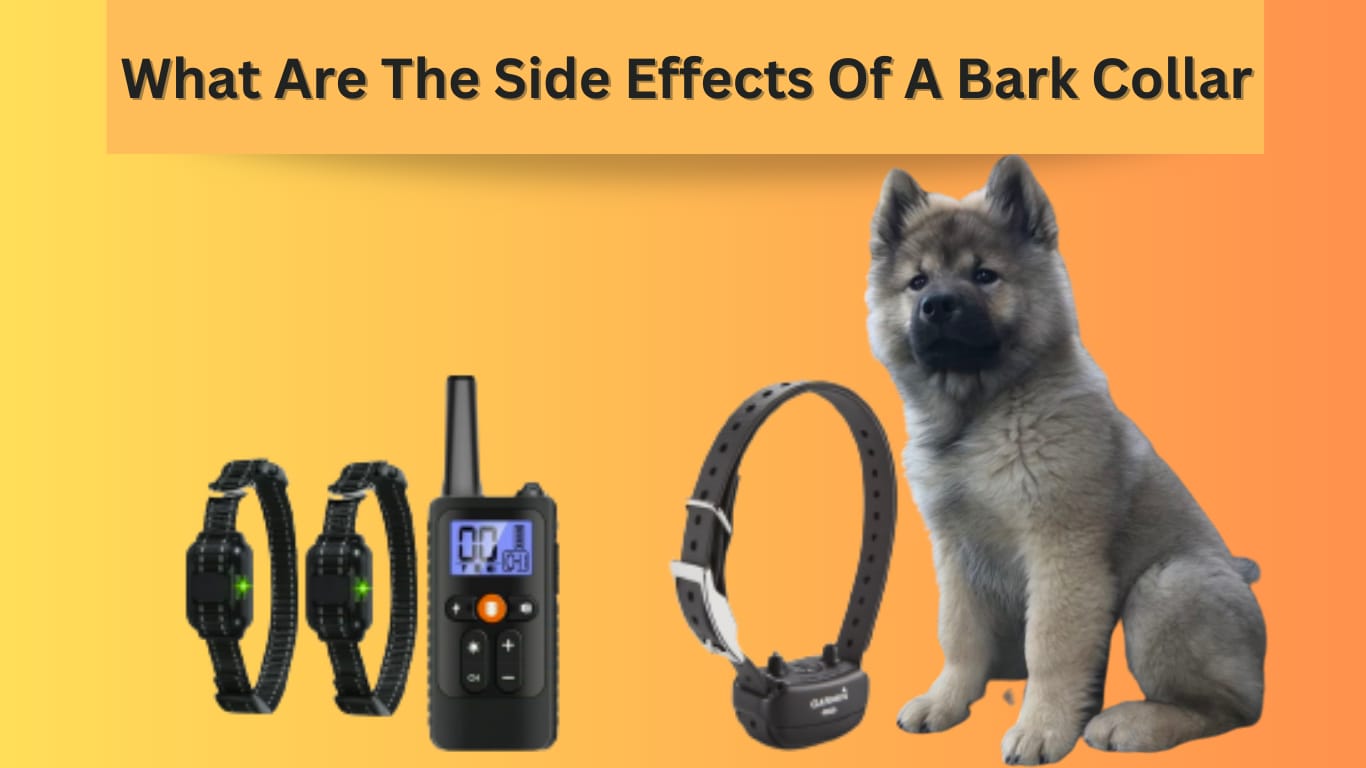Bark Collars: What are the side effects of a bark collar?

What are the side effects of a bark collar?
In the world of dog training, what are the side effects of a bark collar? is a question that often comes to mind. To address this concern comprehensively, let’s get straight to the point: Bark collars, while effective in curbing excessive barking, may have potential side effects that every pet owner should be aware of.
Bark collars, designed to discourage dogs from barking unnecessarily, operate by delivering aversive stimuli. These stimuli can include static shocks, citronella sprays, ultrasonic sounds, or vibrations, depending on the type of collar. While they can be beneficial in modifying behavior and achieving quick results, it’s crucial to recognize that there are potential drawbacks.
One potential side effect of using a bark collar is an increase in stress and anxiety levels in some dogs. The abrupt correction delivered by these devices can startle and distress your furry friend, leading to heightened stress levels. This may manifest as behavioral changes or a general sense of unease in your dog.
Exploring the Side Effects of a Bark Collar
Another concern relates to skin irritation, particularly with static shock collars. If the collar is too tight or worn for extended periods, it can cause discomfort and skin issues. Regular monitoring of your dog’s neck for signs of irritation is essential when using such collars.
Additionally, over-reliance on a bark collar without addressing the root cause of excessive barking may result in dependency. Dogs can become conditioned to behave only when the collar is on, failing to learn proper barking control without it.
What are the side effects of a bark collar?
Understanding Bark Collars
Bark collars, also known as anti-bark collars, are electronic devices designed to curb excessive barking in dogs. They operate on the principle of negative reinforcement, delivering an unpleasant stimulus to deter dogs from barking unnecessarily. These devices come in various types, including citronella spray collars, ultrasonic collars, vibration collars, and static shock collars.
The Benefits of Bark Collars
Effective Training Tool
Bark collars can be an effective tool for addressing persistent barking issues in dogs. When used correctly, they can help modify behavior and reduce excessive noise, leading to a more peaceful coexistence with your canine companion.
Quick Results
One of the significant advantages of bark collars is their ability to produce relatively quick results. When a dog associates excessive barking with an unpleasant consequence, they tend to learn faster and modify their behavior accordingly.
Customizable Settings
Modern bark collars often come with adjustable settings, allowing pet owners to tailor the correction level to their dog’s temperament. This customization ensures that the correction is not overly harsh and is suitable for the specific dog’s needs.
The Drawbacks of Bark Collars
Potential for Stress
While bark collars can be effective, they may also induce stress and anxiety in some dogs. The sudden correction delivered by these devices can startle and frighten your furry friend, leading to increased stress levels.
Skin Irritation
In the case of static shock collars, there is a risk of skin irritation or discomfort, particularly if the collar is too tight or worn for extended periods. It’s crucial to monitor your dog’s neck for any signs of irritation and adjust the collar as needed.
Dependency Issues
Over-reliance on a bark collar without addressing the underlying cause of excessive barking may result in dependency. Dogs may become conditioned to wearing the collar and only behave when it’s on, failing to learn proper barking control without it.
Potential Side Effects of Bark Collars
1. Behavioral Changes
One of the most significant concerns regarding bark collars is the potential for behavioral changes in dogs. In some cases, dogs may become more fearful or aggressive as a response to the collar’s corrections. It’s vital to monitor your pet’s behavior closely when using a bark collar and seek professional guidance if you notice any adverse changes.
2. Vocal Cord Damage
Excessive use or misuse of bark collars, especially static shock collars set at high levels, can potentially cause damage to a dog’s vocal cords. This may result in long-term changes in the dog’s ability to bark or communicate.
3. Fear and Anxiety
The aversive stimuli delivered by bark collars can lead to increased fear and anxiety in some dogs. This heightened anxiety can affect their overall well-being and may manifest in various behavioral issues.
Responsible Use of Bark Collars
To minimize the potential side effects of bark collars, it’s essential to use them responsibly and ethically. Here are some tips for responsible usage:
1. Consult a Professional
Before using a bark collar, consult with a professional dog trainer or veterinarian. They can provide guidance on whether a bark collar is appropriate for your dog’s specific behavior and temperament.
2. Choose the Right Collar
Select a bark collar that is suitable for your dog’s size and needs. Ensure that it has adjustable settings to tailor the correction level appropriately.
3. Monitor Your Dog
Keep a close eye on your dog when using a bark collar. Watch for any signs of distress, anxiety, or changes in behavior. If you notice adverse effects, discontinue use immediately.
4. Combine Training Methods
Use bark collars in conjunction with positive reinforcement training methods. This holistic approach can be more effective in addressing excessive barking and ensuring your dog’s well-being.
In Conclusion
In conclusion, understanding the side effects of a bark collar is essential for responsible dog ownership. Bark collars can be a valuable tool in addressing excessive barking in dogs when used responsibly and ethically. However, it’s essential to be aware of the potential side effects and take measures to minimize them. Always prioritize your dog’s well-being and consult with professionals for guidance on effective and humane training methods.
This may also be helpful for you: What Age Can You Use A Bark Collar On A Dog?
Can You Leave A Bark Collar On All Night?
Do Shock Collars Activate When Another Dog Barks?
Do Bark Collars Work On Large Dogs?
FAQ
1. Are Bark Collars Safe?
Bark collars can be safe when used responsibly and according to the manufacturer’s instructions. It’s crucial to choose the right type of collar for your dog’s size and temperament and ensure it’s not too tight. Consult with a professional if you’re uncertain about its safe use.
2. Are Bark Collars Successful?
Bark collars can be successful in curbing excessive barking when used correctly. They provide a quick response to barking behavior, helping dogs learn to reduce unnecessary noise. However, success depends on factors like the dog’s temperament and consistency in training.
3. How Fast Do Bark Collars Work?
Bark collars can work relatively quickly. Dogs often associate the correction with their barking behavior, leading to behavior modification. Some dogs show improvement within days, while others may take a few weeks to respond effectively.
4. What Causes a Dog to Bark?
Dogs bark for various reasons, including communication, boredom, fear, excitement, or as a response to environmental stimuli. Identifying the specific trigger for your dog’s barking is essential to address the behavior effectively.
5. Are Bark Collars Banned?
Bark collar regulations vary by location. In some places, certain types of bark collars, like shock collars, may be banned or restricted due to concerns about their use. Always check your local laws and regulations before using any bark collar.




